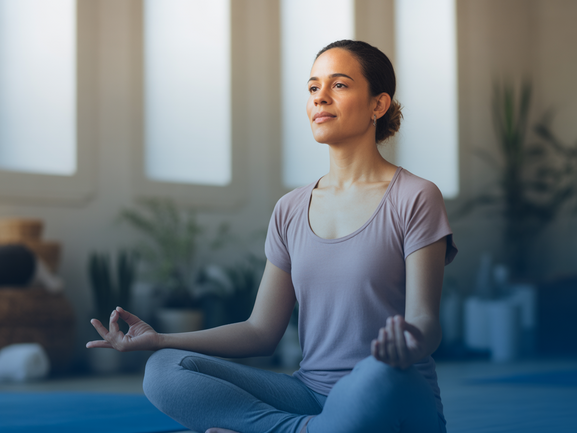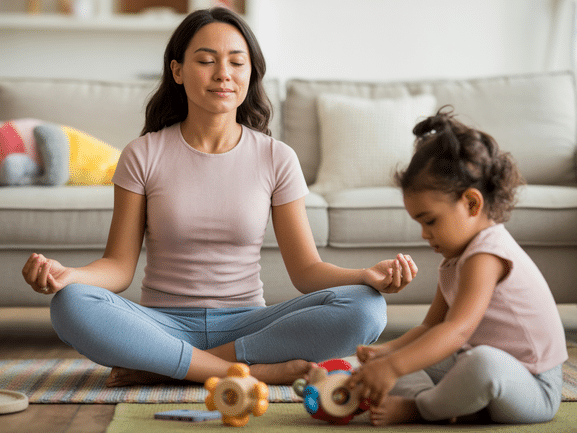Yoga for Depression: A Comprehensive Guide to Finding Relief

What Is Therapeutic Yoga for Depression?
Have you ever felt weighed down by persistent sadness and wondered if a gentle, holistic path to relief exists? Enter yoga for depression, a specialized practice also known as ‘yoga therapy.’ It’s more than just a workout; it is a mind-body discipline that integrates physical postures (asanas), controlled breathing (pranayama), and deep meditation to restore balance to your emotional state and nervous system.
This therapeutic approach provides a powerful tool for self-healing and mental resilience. Luzia, an international yoga instructor and the co-founder of the Vitalizen App | Yoga + Meditation, has centered her life’s work on this principle. After experiencing the transformative effects of yoga on her own mental health, she created Vitalizen to make yoga for depression relief accessible to everyone, particularly those navigating the complexities of mild to moderate depression.
The Science of Calm: How Yoga Rewires Your Brain for Happiness
How can physical movement and breathing truly impact a condition as complex as depression? The answer is rooted in the profound, scientifically-validated connection between the mind and body. The practice of ‘mental health yoga’ directly influences your brain chemistry, hormonal balance, and neurological pathways. Let’s explore the mechanisms behind this transformation.
Regulating the Autonomic Nervous System
Depression is often linked to a hyperactive sympathetic nervous system—our ‘fight-or-flight’ response. Yoga’s slow, deliberate movements and mindful breathing activate the parasympathetic nervous system, also known as the ‘rest-and-digest’ state. This shift helps lower chronic stress, reduces anxiety, and fosters a deep sense of inner calm, creating an environment where healing can begin.
Decreasing Cortisol Levels
Cortisol is the body’s primary stress hormone. While essential in small doses, chronically elevated levels are a hallmark of depression. Multiple studies have confirmed that a consistent yoga practice significantly lowers cortisol. By mitigating this hormonal imbalance, yoga for depression helps lift the physiological weight of sadness and fatigue.
Boosting Mood-Elevating Neurotransmitters
Yoga is a natural mood booster. It has been shown to increase the production of key neurotransmitters associated with happiness and well-being. These include:
- Endorphins: The body’s natural opiates, which create feelings of pleasure and reduce pain.
- GABA (Gamma-aminobutyric acid): An inhibitory neurotransmitter that calms the nervous system. Low GABA levels are linked to anxiety and mood disorders.
- Serotonin: A critical neurotransmitter for mood regulation, often targeted by antidepressant medications.
Promoting Mindfulness and Neuroplasticity
A core component of depression is rumination—a relentless cycle of negative thoughts. Yoga interrupts this pattern by anchoring your attention to the present moment: the sensation of a stretch, the rhythm of your breath. This practice of mindfulness strengthens the prefrontal cortex, the brain region responsible for emotional regulation. Over time, this builds neuroplasticity, allowing your brain to form new, more positive neural pathways.
“A 2024 study in the Journal of Psychiatric Research found that participants in an 8-week yoga for depression program showed a significant reduction in symptoms, with effects comparable to some traditional therapies.”
5 Beginner-Friendly Yoga Poses for Depression Relief
You don’t need to be a flexible acrobat to benefit from yoga. The most effective poses for mental wellness are often the simplest. Here are five beginner-friendly asanas you can try today. Hold each pose for 5-10 deep breaths.
-
Child’s Pose (Balasana): A gentle resting pose that calms the mind and releases tension in the back and shoulders.
Instructions: Kneel on the floor, sit back on your heels, and fold forward, resting your forehead on the mat. Your arms can be stretched forward or rest alongside your body.

-
Cat-Cow Stretch (Marjaryasana-Bitilasana): This dynamic duo links breath with movement, releasing spinal tension and calming the mind.
Instructions: Start on your hands and knees. As you inhale, drop your belly and look up (Cow). As you exhale, round your spine and tuck your chin (Cat). -
Bridge Pose (Setu Bandhasana): A gentle inversion that can help alleviate anxiety and fatigue by improving circulation.
Instructions: Lie on your back with your knees bent and feet flat on the floor. Press into your feet to lift your hips off the ground.

-
Legs-Up-The-Wall Pose (Viparita Karani): The ultimate restorative pose. It calms the nervous system and reduces stress.
Instructions: Sit sideways against a wall, then swing your legs up the wall as you lie back. Rest with your arms by your sides. -
Corpse Pose (Savasana): A pose of total relaxation that allows your body to integrate the benefits of the practice.
Instructions: Lie flat on your back, with your arms and legs spread comfortably. Close your eyes and focus on your breath for 5-10 minutes.
Why an International Teacher Created Vitalizen
Luzia’s passion for sharing the gift of yoga took her across continents. Her international experience in the United States, Canada, France, and Italy allowed her to refine a unique style that addresses the physical, emotional, and mental aspects of well-being. She witnessed a universal need for accessible mental health support.
This journey solidified her mission: to offer ‘yoga for depression relief’ in a modern, accessible format. She saw that barriers like cost, location, and stigma prevented many from seeking help. Therefore, she co-created Vitalizen to bring her expertise as an ‘online yoga teacher’ directly to you, wherever you are in the world.
Key Benefits of Using Yoga for Mental Wellness
Integrating therapeutic yoga into your life offers more than just symptom management; it provides a foundation for lasting mental wellness. The benefits are both immediate and long-term, helping you build resilience and self-awareness.
- Unmatched Accessibility: With an app like Vitalizen, you can practice anywhere, anytime. This removes traditional barriers like studio fees, travel time, and scheduling conflicts, making consistency achievable.
- Fosters Self-Compassion: Yoga encourages a non-judgmental connection with your body and mind. This practice is a powerful antidote to the negative self-talk and criticism that often accompany depression, helping you build inner peace.
- Improves Overall Physical Health: The mind and body are inseparable. Yoga improves flexibility, strength, and sleep quality, which in turn boosts your energy levels and overall resilience to stress.
- Empowers You with Self-Regulation Tools: Learning breathing techniques and mindfulness gives you a toolkit to manage difficult emotions as they arise in daily life, reducing feelings of helplessness.
How the Vitalizen App Guides Your Journey
Understanding the challenges of seeking help, Luzia designed the Vitalizen app to be your personal sanctuary. It’s more than a collection of videos; it’s a comprehensive tool designed to support your mental health journey. The app combines Luzia’s experience with a structured program to provide genuine yoga for depression relief right at your fingertips.
With guided meditations, personalized yoga sessions, and a supportive community, Vitalizen offers a safe and accessible space to heal and grow. It is specifically crafted to guide you, even if you have never done yoga before.
💡 Tip: Start with the “Foundations of Calm” program in the Vitalizen app. It’s a 7-day series designed specifically for beginners looking for mental wellness.
How to Start with Yoga for Depression Today
Taking the first step is often the hardest part, but you can begin your journey toward mental wellness in just a few minutes. Here’s a simple, actionable plan to get started with the Vitalizen app:
- Download the App: Find Vitalizen on your device’s app store and create your account.
- Try a Beginner Session: Start with a short, 10-minute guided practice from the “Beginner” category.
- Be Consistent, Not Perfect: Aim for just 2-3 sessions per week to start building a sustainable routine. Consistency is more important than intensity.
- Explore and Grow: As you become more comfortable, explore different meditations and yoga styles available in the app to discover what resonates most with you.
Frequently Asked Questions
Here are answers to common questions about using yoga for depression and the Vitalizen app.


